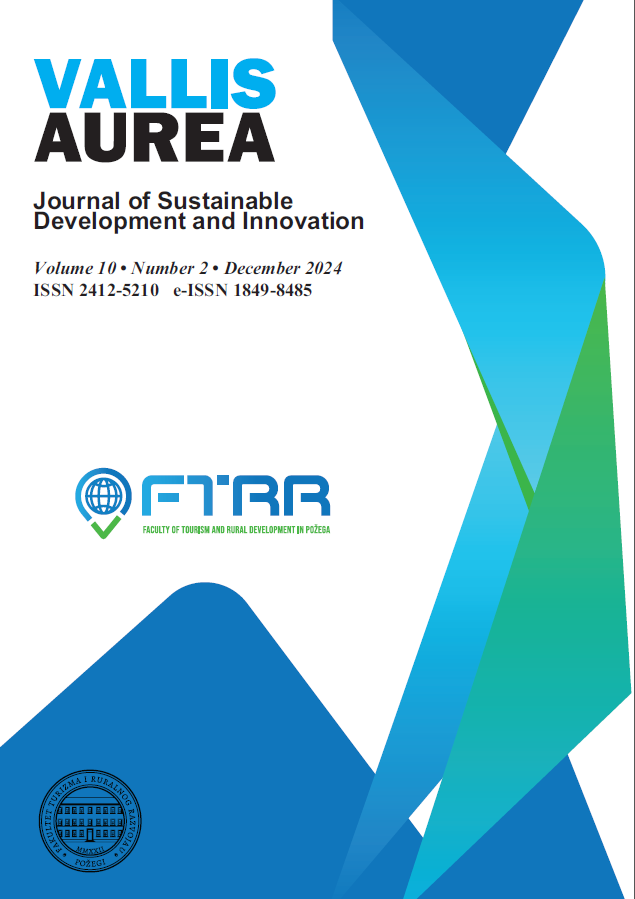Reevaluating the Role of Foreign Direct Investment in Albania's Economic Growth: Policy Implications for Growth and Openness
DOI:
https://doi.org/10.62598/JVA.10.2.4.9Keywords:
Impulse analysis; FDI; Economic transition; GDP; Short-run dynamics; Long-runAbstract
Based on the standard vector error correction model with quarterly data, this study focuses on the relationship between inflows of exports, foreign investments together with Gross Domestic Product, of the last decades in Albania to research in both the short-run dynamics and the long-run trends.
Using diverse secondary data with differing methods of data collection over time and especially dealing with data collected during the economic transition period, presents a challenge in terms of reliability of the data that can lead thus to studies which may result in controversial conclusions for the same country.
The impulse analysis reveals that foreign direct investment inflows cause an almost negligible (positive) fluctuation in exports and a (negative) fluctuation in GDP in the long run. Conversely, exports, after a short-term negative impact, lead to an increase in FDI inflows in the long run and a slight increase in the GDP level. Finally, GDP has a positive effect on both variables. The result, therefore, is very important as it suggests that the government should focus on openness, growth and exports—devaluating thus the role of FDI inflows, at least in the short term.
References
1. Aisen, A., & Veiga, F. J. (2013). How does political instability affect economic growth? European Journal of Political Economy, 29 151–167.
2. Boriçi, Y.K., and Osmani, E. (2015) Foreign Direct Investment and Economic Growth in Albania. Economics, 3, 27–32.
3. Botrić, V.,and Škuflić, L. (2006) Main Determinants of Foreign Direct Investment in the Southeast European Countries. Transition Stud Rev 13, 359–377 https://doi.org/10.1007/s11300-006-0110-3
4. Clemens, W. C. (2010). Ethnic peace, ethnic conflict: Complexity theory on why the Baltic is not the Balkans. Communist and Post-Communist Studies, 43(3), 245–261.
5. Demekas, D.G.; Horváth, B.; Ribakova, E.; Wu, Y. (2005) Foreign Direct Investment in Southeastern Europe: How (and how much) can policies help?
6. Demeti, A., and Rebi, E. (2014) Foreign direct investments (FDI) and Productivity in Albania. Interdisciplinary Journal of Research and Development, 1, 7–14.
7. Dickey, D. A., and W. A. Fuller. (1979) Distribution of the estimators for autoregressive time series with a unit root. Journal of the American Statistical Association 74: 427–31
8. Eren, M., & Zhuang, H. (2015). Mergers and acquisitions versus greenfield investment, absorptive capacity, and economic growth: Evidence from 12 new member states of the European Union. Eastern European Economics, 53(2), 99–123. https://doi.org/10.1080/00128775.2015.1033240
9. Falk, M. (2015). The relationship between FDI through backward linkages and technological innovations of local firms: Evidence for emerging economies. Eastern European Economics, 53(5), 424–438. https://doi.org/10.1080/00128775.2015.1065507
10. Granger, C. W. (1988). Causality, cointegration, and control. Journal of Economic Dynamics and Control, 12(2-3), 551-559.
11. Golitsis, P., Avdiu, K., and Szamosi, L.T. (2018) Remittances and FDI Effects on Economic Growth: A VECM and GIRFs for the Case of Albania. Journal of East-West Business, 24, 188–211.
12. Hobbs, S., Paparas, D., and AboElsoud, M.E. (2021) Does Foreign Direct Investment and Trade Promote Economic Growth? Evidence from Albania. Economies, 9(1), 1. https://doi.org/10.3390/economies9010001
13. Hysa, E., and Hodo, L. (2016) Foreign direct investment and economic growth in Albania: A co-integration analysis. International Economics, 234–244.
14. Jakšić, S., Erjavec, N., & Cota, B. (2018). The role of foreign direct investment and labor productivity in explaining croatian regional export dynamics. Central European Journal of Operations Research, 27(3), 835–849. https://doi.org/10.1007/s10100-018-0583-2.
15. Janicki, H.P., and Wunnava, P.V. (2004) Determinants of foreign direct investment: empirical evidence from EU accession candidates. Applied Economics, 36(5), 505–509.
16. Johansen, S. (1988) Statistical analysis of cointegration vectors. Journal of Economic Dynamics and Control 12: 231–54.
17. Jong-A-Pin, R. (2009). On the measurement of political instability and its impact on economic growth. European Journal of Political Economy, 25(1), 15–29.
18. Mateev, M. (2008) Corporate governance problem and its implications for transition economies. Corporate Ownership & Control, 5(3-3), 335–348.
19. Nath, H. K. (2009). Trade, foreign direct investment, and growth: Evidence from transition economies. Comparative Economic Studies, 51(1), 20–50.
20. Sapienza, E. (2010) Foreign Direct Investment and growth in Central, Eastern and Southern Europe. Investigación Económica, 69, 99–138.
21. Segal, M. R. (2004). Machine learning benchmarks and random forest regression.
22. Sherstinsky, A. (2020). Fundamentals of recurrent neural network (RNN) and long short-term memory (LSTM) network. Physica D: Nonlinear Phenomena, 404, 132306.
23. Welfe, W. (2013). The models of the Middle and East European Countries. In: Macroeconometric Models. Advanced Studies in Theoretical and Applied Econometrics, vol 47. Springer, Berlin, Heidelberg, 123–190. https://doi.org/10.1007/978-3-642-34468-8_9
24. Weyerstrass, K. (2008). Economic policies on Slovenia’s road to the euro area. Economic Systems, 32(1), 92–102. https://doi.org/10.1016/j.ecosys.2007.09.003
25. Weyerstrass, K., Haber, G., & Neck, R. (2001). SLOPOL1: A macroeconomic model for Slovenia. International Advances of Economic Resources, 7(1), 20–37.
Downloads
Published
Issue
Section
License
Copyright (c) 2024 Vallis Aurea

This work is licensed under a Creative Commons Attribution-NonCommercial-NoDerivatives 4.0 International License.
Authors of papers for publishing in the journal agree under a Creative Commons Attribution-NonCommercial-NoDerivatives 4.0 International License.https://creativecommons.org/licenses/by-nc-nd/4.0/







